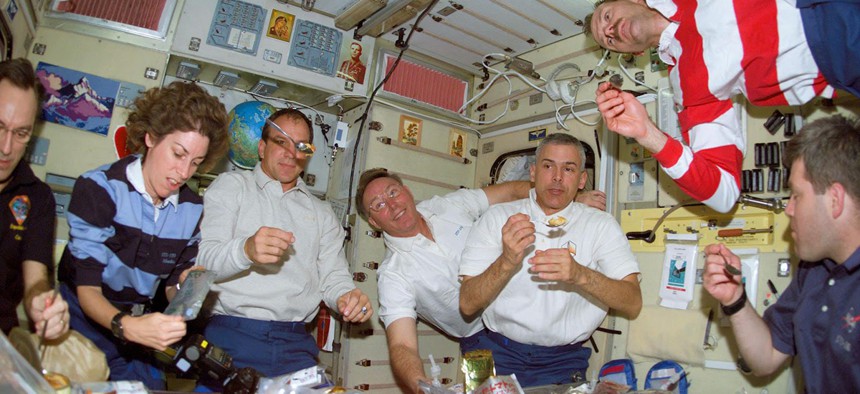The First Humans Sent to Mars Will Need to 3D Print Their Meals

The crew of shuttle mission STS-110 eats dinner NASA
Current 'space' food just won't cut it.
For humans to maintain a healthy existence here on earth, our food system must be safe, nutritious, and sustainable. But how does this change when we travel to space?
Since 2000, the International Space Station has been a home to over 100 space travelers. Constrained by microgravity and no refrigeration, the current food system in space consists of fully processed, individually packaged foods. This food system is further limited by mass, volume, water, and crew time constraints. (After all, there’s only so much space in a rocket, and an astronaut’s time would be much better spent working on science experiments than preparing meals.)
The current menu of space-friendly foods uses processing and water-reduction strategies to make these meals shelf stable. For example, a shrimp cocktail, mashed potatoes, and strawberries can be freeze dried; beef stew, candied yams, and brown rice can be thermostabilized; beef steak and turkey can be irradiated; and brownies, bread products, and beverage powders can be brought up in a low-moisture or dried form.
As tasty as this feast sounds, this packaged food system does not meet the five-year shelf life required for a Mars mission, nor will it feed generations there in the years to come. How will space food therefore have to change if we are ever to colonize other planets?
Extreme road-trip snacks
Using existing space technologies, it will take up to 32 months to travel to Mars. How can you feed a crew for that three-year trip?
During a long-duration space mission, a large variety of food is needed to prevent menu fatigue among astronauts, which leads to lower food consumption and can affect their health. You don’t want to waste food, either: It currently costs about $10,000 to launch one pound of food to the ISS, and the cost for a Mars mission is expected to be much higher. So while food variety is important, so too is the cost of food.
Technically NASA’s shelf-stable food would be safe to eat after five years, but after two years, most of the food’s nutritional content is significantly depleted. Even if the shelf life of packaged foods could be extended to five years, it would require almost 11,000kg of food to feed six crew members for the duration of a Mars mission. (About 17% of that mass would be attributed to packaging that would turn into trash—and garbage cannot be just left on the planet surface in a Mars mission.)
NASA is therefore considering food-preservation technologies that could extend the shelf life of food in space. Pressure-assisted thermal sterilization (PATS) uses a combination of placing the foods under high pressure with a reduced sterilization temperature to inactivate harmful microorganisms that cause food to spoil. Since the food is exposed to less heat, the quality of the food is higher after processing and can be maintained for a longer period of time. Microwave sterilization, which inactivates microorganisms using microwaves, is also being considered.
Eating on Mars
These methods could get us to Mars, but what happens when we arrive?
Fruits and vegetables could be grown hydroponically in greenhouses, giving space travelers access to fresh foods. Greenhouses would provide control over temperature, humidity, and light. Tomatoes, peppers, potatoes, strawberries, and onions would be suitable for hydroponic growing.

Baseline crops that we rely on on Earth such as wheat, rice, peanuts, and dried beans have too much biomass to be grown on other planets; their inedible leaves and roots would only create excess waste. These products could therefore be launched in bulk and processed into edible ingredients such as bread, pasta, tofu, and oil on the surface of Mars. This option would require the development of food processing and preparation equipment, as well as significant crew time.
3D printing could provide a solution to all of these shortcomings and help develop a viable food system on Mars. Pastes made with water, bulk protein, and carbohydrate powders would serve as the base for 3D-printed food. By combining vitamin and mineral mixtures, flavors, colors, and oils to the pastes, the 3D-produced foods could be tailored to meet the personal nutritional needs and taste preferences of each crew member—a crew member could make a pizza with tomato sauce one day and pesto sauce the next. They would be able to create a diverse menu, and with minimal waste.
Heaven on Earth
3D printing may feed us on Mars, but it can also help us here on Earth. For example, this technology could improve the nutritional content of foods consumed in regions that lack access to healthy options. Insects and algae are not considered socially acceptable foods in most cultures, but if they are dried and ground into powders, they could be added to other ingredients to produce edible and nutritious foods. 3D printing could also help seniors or other people who are only able to eat pureed foods add more variety and nutrition to their diet.
While the food system for the Mars missions will not be finalized for at least a decade, food scientists are already working to assess the technologies that can provide the correct nutrition. The commercial use of 3D printing is still in the nascent stages, but applications of the technology could be game-changing as we continue to explore the universe around us.


